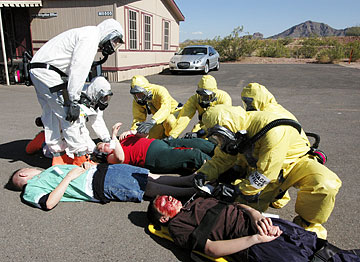IN THE MILITARY

GREGG K. KAKESAKO / GKAKESAKO@STARBULLETIN.COM
Hawaii Air National Guard decontamination experts don grey and yellow suits to assess casualties suspected of being exposed to biological, gas or nerve agents during a multi-state mass casualty held in Arizona over the past two weeks.
|
|
Isle medic helps in simulated terror attack
Hawaii Air Guard units travel to Arizona for the drill
PHOENIX » Hawaii Air National Guard Col. Brett Wyrick has put his medical career on hold.
Last year, he temporarily shut down his 15-year-old surgical practice in Hilo and volunteered to spend six months in Balad, where his facility was routinely attacked by mortars and rockets working as an Air Force doctor.
"I was watching television and all that fighting and dying in Iraq," said Wyrick, 46, "I knew I had to do something."
He volunteered and was assigned to the Air Force hospital in Balad -- in the heart of Sunni insurgency -- and ended up performing 190 major trauma surgeries and 450 other types of operations during his six-month tour.
For the past few weeks Wyrick again has taken leave from his Hilo practice.
This time, he led 69 members of the Hawaii Air National Guard's 154th Medical Group to Papago National Guard Base in southwest Arizona. Along with 120 members of the California Army National Guard they participated in a simulated terrorist attack exercise.
The job of the 154th Medical Group, which Wyrick commands, for the past two weeks was to test its ability to decontaminate large numbers of people suspected of being exposed to chemical, biological, and gas agents.
The training has prepared Wyrick's unit for possible future deployments to Indonesia and the Philippines, said Maj. Gen. Bob Lee, state adjutant general for Hawaii.
More than 3,000 people, involving National Guard units from six states, were activated to help the city of Scottsdale recover from a large scale simulated attack by terrorists. Scottsdale with its population of 250,000 was placed in the cross hairs of terrorists because it is also the home of General Dynamic -- a major defense contractor.
The mock attack started with the bombing of Hoover Dam and resulted in mass causalities, electrical blackouts, water contamination and then the possibility of radiation and sarin gas in the air and water.
The exercise was called "Coyote Crisis Campaign" and brought together a mobile hospital from the Michigan Air National Guard manned by 500 military medics and 100 civilian doctors. The hospital was used during the Hurricane Katrina relief efforts.
Hawaii contributed a team of chemical, biological and radiation experts from the 154th Medical Group.
Hawaii also provided its newest C-17 Globemaster cargo jet flown by members of the 204th Airlift Squadron that flew an air evacuation mission moving 11 litter-bound and 18 other patients portrayed by local ROTC students
Wyrick said this was the first time he had to move his team and all their decontamination equipment by air. "It was also the first time we were able to integrate two separate packages (units) from different locations to work together."
Wyrick's team provided the experts to search and extract biological, chemical or radiological agents as well as a team of medical doctors, nurses and technicians. The special decontamination team from the California Army National Guard screened patients for any suspicious agent before they could be medically treated.
Wyrick said his unit was able to cut in half the 90-minute response time set by military planners to erect and establish a decontamination facility.
"My goal is to get to the people fast," Wyrick said. "The longer they are in the 'hot zone' means the loss of a father, mother or a loved one."
There were even training traces of a nerve or gas agent planted on some "casualties" to make the "sniffer" process -- where electronic sensing devices are used -- more realistic.
At a briefing Col. Randall Falk, National Guard Bureau Air Surgeon, told Lee and observers from the Queen's Medical Center that mass casualty drills help the staff and physicians in the Scottsdale Heathcare hospital system prepare to respond to large scale disasters.
Three years ago the Arizona National Guard initiated a military-civilian training partnership which helps National Guard medical units maintain their proficiency.
This kind of partnership and understanding is crucial when a local hospital will have to increase its capabilities to respond to a pandemic flu, floods, hurricanes and other disasters since that is when military medical units will be called in to supplement local needs, Falk said.
Mary Kopp, a key figure in the Scottsdale Healthcare disaster preparedness team, said "the beauty of this partnership is the shared community response. In time of emergency we each know how the other operates."
Dr. Thomas Wachtel, Scottsdale's trauma services medical services director, added that National Guard medical technicians who have participated in the hospital's training program said it paid off when they were deployed to Iraq.
It is something Hawaii National Guard planners would like to establish in Hawaii with Queen's since it is the only trauma center in Honolulu.
Karen Schultz, the Queen's Medical Center vice president, said such a military partnership would be beneficial during any type of disaster. "If there is a disaster on Oahu we would have to work together and it would be helpful if we already had that relationship," she said.
Schultz acknowledged that there are legal, liability, accreditation and other issues that need to be addressed. However, Schultz added: "I don't think they are insurmountable."

